Thermador MED301WS, MEDMC301WS, ME301WS, ME302WS, MED301LWS Maintance Manual
...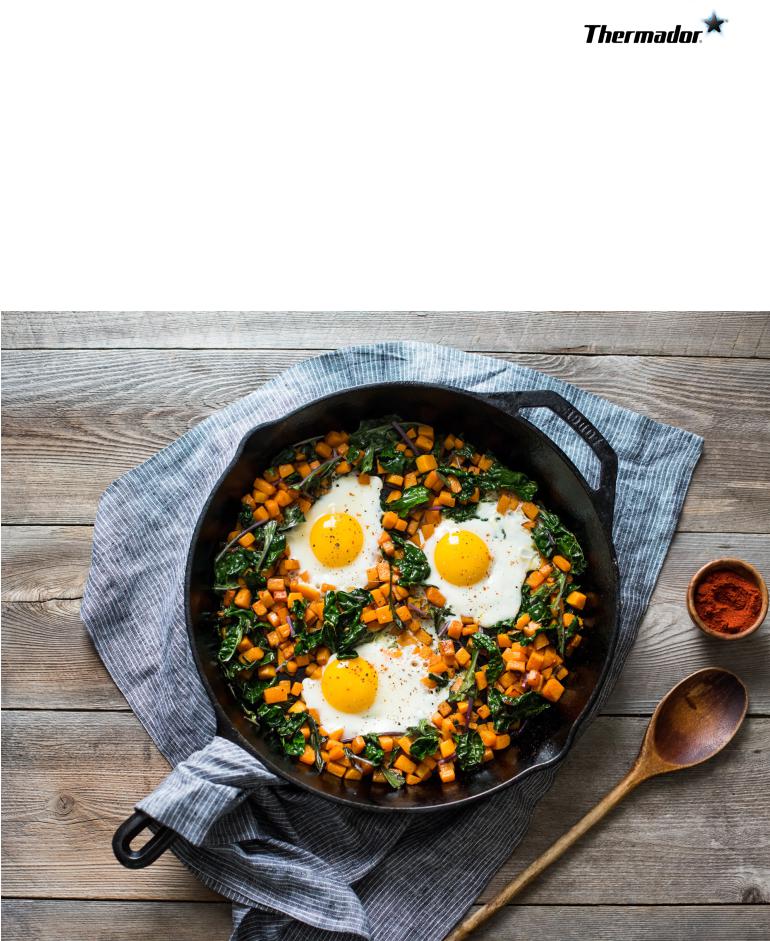
Use and care
G U I D E |
ME301WS MED301WS MED301LWS |
MED301RWS ME302WS MED302WS |
|
|
MED302LWS MED302RWS MEM301WS |
Masterpiece® Series Built-in oven |
MEDMC301WS MEDMCW31WS |
|
T H E R M A D O R . C O M

Table of
C O N T E N T S
Safety Definitions ....................................................... |
4 |
IMPORTANT SAFETY INSTRUCTIONS ........................ |
5 |
Proper Installation and Maintenance .............................. |
5 |
Fire Safety ....................................................................... |
5 |
Burn Prevention .............................................................. |
6 |
Child Safety ..................................................................... |
6 |
Cleaning Safety ............................................................... |
6 |
Cookware Safety ............................................................. |
7 |
Warming Drawer Safety .................................................. |
7 |
State of California Proposition 65 Warning: ................... |
7 |
Causes of Damage ...................................................... |
8 |
Protecting the Environment ....................................... |
8 |
Saving Energy ................................................................. |
8 |
Accessories ................................................................. |
9 |
Accessories Included ...................................................... |
9 |
Special Accessories (not included) .................................. |
9 |
Getting to Know the Appliance ................................ |
10 |
Oven Overview ............................................................. |
10 |
Oven Cavities ................................................................ |
10 |
Oven Cavity Features .................................................... |
11 |
Control Panel ................................................................ |
11 |
Main Menu .................................................................... |
12 |
Heating Modes Menu ................................................... |
13 |
Before First Use ........................................................ |
15 |
Before Using the Appliance for the First Time ............. |
15 |
Initial Use ....................................................................... |
15 |
Cleaning the Accessories .............................................. |
16 |
Adjust Basic Settings .................................................... |
16 |
General Operation ................................................... |
17 |
High Altitude Baking ..................................................... |
17 |
Switching the Appliance On and Off ............................ |
17 |
Timer Options ............................................................... |
17 |
Setting a Heating Mode ............................................... |
18 |
Changing or Cancelling the Appliance Operation ....... |
19 |
Fast Preheat .................................................................. |
20 |
Panel Lock ..................................................................... |
20 |
Auto Convection Conversion ........................................ |
20 |
Temperature Offset ....................................................... |
20 |
Meat Probe ................................................................... |
21 |
Sabbath Mode .............................................................. |
22 |
Yom Tov Mode .............................................................. |
23 |
Rack Positions ............................................................... |
24 |
Inserting Racks .............................................................. |
24 |
Rotisserie ....................................................................... |
25 |
Warming Drawer Operation .................................... |
27 |
Setting the Warming Drawer ........................................ |
27 |
Warming Empty Serving Bowls and Plates ................... |
28 |
Warming Drawer Charts ................................................ |
28 |
Remove Drawer Insert ................................................... |
28 |
Home Connect ......................................................... |
30 |
Setting Up ..................................................................... |
30 |
Remote Start ................................................................. |
32 |
Home Connect Settings ................................................ |
32 |
Software Update ........................................................... |
33 |
Information on Data Protection .................................... |
33 |
Wi-Fi® Module .............................................................. |
33 |
Cleaning Your Oven ................................................. |
34 |
Suitable Cleaning Agents ............................................. |
34 |
Surfaces in the Oven Cavity .......................................... |
35 |
Keeping the Appliance Clean ....................................... |
35 |
Easy Clean ..................................................................... |
36 |
Self Clean ...................................................................... |
36 |
Avoid These Cleaners ................................................... |
37 |
Service ..................................................................... |
38 |
Troubleshooting Chart .................................................. |
38 |
Maximum Operating Time Exceeded ........................... |
39 |
Oven Light ..................................................................... |
39 |
Product Rating Label ..................................................... |
41 |
How to Obtain Service or Parts .................................... |
41 |
STATEMENT OF LIMITED PRODUCT WARRANTY ... 42 |
|
What this Warranty Covers & Who it Applies to .......... |
42 |
How Long the Warranty Lasts ....................................... |
42 |
Repair/Replace as Your Exclusive Remedy ................... |
42 |
Out of Warranty Product ............................................... |
42 |
Warranty Exclusions ...................................................... |
42 |
THERMADOR® Support .......................................... |
43 |
Service ........................................................................... |
43 |
Parts and Accessories ................................................... |
43 |

Safety Definitions
9WARNING
This indicates that death or serious injuries may occur as a result of non-observance of this warning.
9CAUTION
This indicates that minor or moderate injuries may occur as a result of non-observance of this warning.
NOTICE: This indicates that damage to the appliance or property may occur as a result of non-compliance with this advisory.
Note: This alerts you to important information and/or tips.
4

9 IMPORTANT SAFETY INSTRUCTIONS
READ AND SAVE THESE INSTRUCTIONS
WARNING
When properly cared for, your new appliance has been designed to be safe and reliable. Read all instructions carefully before use. These precautions will reduce the risk of burns, electric shock, fire, and injury to persons. When using kitchen appliances, basic safety precautions must be followed, including those in the following pages.
Proper Installation and Maintenance
Have the installer show you the location of the circuit breaker or fuse. Mark it for easy reference.
This appliance must be properly installed and grounded by a qualified technician. Connect only to properly grounded outlet. Refer to Installation Instructions for details.
This appliance is intended for normal family household use only. It is not approved for outdoor use. See the Statement of Limited Product Warranty. If you have any questions, contact the manufacturer.
Do not store or use corrosive chemicals, vapors, flammables or nonfood products in or near this appliance. It is specifically designed for use when heating or cooking food. The use of corrosive chemicals in heating or cleaning will damage the appliance and could result in injury.
Do not operate this appliance if it is not working properly, or if it has been damaged. Contact an authorized servicer.
Do not obstruct oven vents.
Do not repair or replace any part of the appliance unless specifically recommended in this manual. Refer all servicing to an authorized servicer.
In the event of an error the display will show an error code. If pressing the TIMERS button does not resolve the error, disconnect the appliance from the power supply and call Customer Service.
WARNING
When removing the door make sure oven is cool and power to the oven has been turned off before removing the door. Failure to do so could result in burns.
The oven door is heavy and fragile. Use both hands to remove the oven door. The door front is glass. Handle carefully to avoid breaking.
Grasp only the sides of the oven door. Do not grasp the handle as it may swing in your hand and cause injury or damage.
Failure to grasp the oven door firmly and properly could result in personal injury or product damage.
Lay the door on a flat smooth surface so that the door cannot fall over. Failure to do so may result in personal injury or damage to the appliance.
WARNING
To avoid injury from hinge bracket snapping closed, be sure that both levers are securely in place before removing door. Also, do not force door open or closed - the hinge could be damaged and injury could result.
WARNING
Make sure the appliance and lights are cool and power to the appliance has been turned off before replacing the light bulb(s). Failure to do so could result in electrical shock or burns. The lenses (if equipped) must be in place when using the appliance. The lenses (if equipped) serve to protect the light bulb from breaking. The lenses (if equipped) are made of glass. Handle carefully to avoid breaking. Broken glass can cause an injury.
WARNING
Light socket is live when door is open if main power supply is not turned off. To avoid electric shock disconnect main fuse or circuit breaker before accessing light bulb(s).
Fire Safety
WARNING
NEVER cover any slots, holes or passages in the oven bottom or cover an entire rack with materials such as aluminum foil. Doing so blocks air flow through the oven. Aluminum foil linings may also trap heat, causing a fire hazard.
If materials inside an oven or warming drawer should ignite, keep door closed. Turn off the appliance and disconnect the circuit at the fuse or circuit breaker panel.
WARNING
Use this appliance only for its intended use as described in this manual. NEVER use this appliance as a space heater to heat or warm the room. Doing so may result in overheating the appliance. Never use the appliance for storage.
Always have a working smoke detector near the kitchen.
In the event that personal clothing or hair catches fire, drop and roll immediately to extinguish flames.
Have an appropriate fire extinguisher available, nearby, highly visible and easily accessible near the appliance.
Smother flames from food fires other than grease fires with baking soda. Never use water on cooking fires.
5

9 IMPORTANT SAFETY INSTRUCTIONS
READ AND SAVE THESE INSTRUCTIONS
WARNING
TO REDUCE THE RISK OF INJURY TO PERSONS IN THE EVENT OF A GREASE FIRE, OBSERVE THE FOLLOWING:
a.SMOTHER FLAMES with a close-fitting lid, cookie sheet, or metal tray, then turn off the burner. BE CAREFUL TO PREVENT BURNS. If the flames do not go out immediately, EVACUATE AND CALL THE FIRE DEPARTMENT.
b.NEVER PICK UP A FLAMING PAN – You may be burned.
c.DO NOT USE WATER, including wet dishcloths or towels – a violent steam explosion will result.
d.Use an extinguisher ONLY if:
-You know you have a Class ABC extinguisher, and you already know how to operate it.
-The fire is small and contained in the area where it started.
-The fire department is being called.
-You can fight the fire with your back to an exit.
Burn Prevention
DO NOT TOUCH HEATING ELEMENTS OR INTERIOR SURFACES OF OVEN - Heating elements may be hot even though they are dark in color. Interior surfaces of an oven become hot enough to cause burns. During and after use, do not touch, or let clothing, potholders, or other flammable materials contact heating elements or interior surfaces of oven until they have had sufficient time to cool. Other surfaces of the appliance may become hot enough to cause burns. Among these surfaces are oven vent openings, surfaces near these openings and oven doors.
Exercise caution when opening the appliance. Standing to the side, open the door (or drawer) slowly and slightly to let hot air and/or steam escape. Keep your face clear of the opening and make sure there are no children or pets near the unit. After the release of hot air and/or steam, proceed with your cooking. Keep doors shut unless necessary for cooking or cleaning purposes. Do not leave open doors unattended.
Do not heat or warm unopened food containers. Build-up of pressure may cause the container to burst and cause injury.
Use caution when cooking foods with high alcohol content (e.g. rum, brandy, bourbon) in the oven. Alcohol evaporates at high temperatures. There is a risk of burning as the alcohol vapors may catch fire in the oven. Use only small quantities of alcohol in foods, and open the oven door carefully.
Always place oven racks in desired location while oven is cool. Always use oven mitts, when the oven is warm. If a rack must be moved while oven is hot, do not let potholder contact the heating elements.
CAUTION
To avoid possible injury or damage to the appliance, ensure rack is installed exactly per installation instructions and not backwards or upside down.
Always use dry potholders. Moist or damp potholders on hot surfaces may result in burns from steam. Do not let potholder touch hot heating elements. Do not use a towel or other bulky cloth.
Secure all loose garments, etc. before beginning. Tie long hair so that it does not hang loose, and do not wear loose fitting clothing or hanging garments, such as ties, scarves, jewelry, or dangling sleeves.
Child Safety
When children become old enough to use the appliance, it is the responsibility of the parents or legal guardians to ensure that they are instructed in safe practices by qualified persons.
Do not allow anyone to climb, stand, lean, sit, or hang on any part of an appliance, especially a door, warming drawer, or storage drawer. This can damage the appliance, and the unit may tip over, potentially causing severe injury.
Do not allow children to use this appliance unless closely supervised by an adult. Children and pets should not be left alone or unattended in the area where the appliance is in use. They should never be allowed to play in its vicinity, whether or not the appliance is in use.
WARNING
Items of interest to children should not be stored in an appliance, in cabinets above an appliance or on the backsplash. Children climbing on an appliance to reach items could be seriously injured.
Cleaning Safety
IMPORTANT SAFETY NOTICE: The California Safe Drinking Water and Toxic Enforcement Act requires the Governor of California to publish a list of substances known to the state to cause cancer, birth defects or other reproductive harm, and requires businesses to warn customers of potential exposure to such substances. The burning of gas cooking fuel and the elimination of soil during self-cleaning can generate some by-products which are on the list. To minimize exposure to these substances, always operate this unit according to the instructions contained in this booklet and provide good ventilation.
When self-cleaning, confirm that the door locks and will not open. If the door does not lock, do not run SelfClean. Contact service.
Wipe out excessive spillage before self-cleaning the oven.
Birds have very sensitive respiratory systems. Keep pet birds out of the kitchen or other rooms where kitchen
6

9 IMPORTANT SAFETY INSTRUCTIONS
READ AND SAVE THESE INSTRUCTIONS
fumes could reach them. During self-clean, fumes are released that may be harmful to birds. Other kitchen fumes such as overheating margarines and cooking oils may also be harmful.
Keep oven free from grease build up.
WARNING
RISK OF INJURY
Scratched glass in the appliance door can burst. Do not use any glass scrapers or strong or abrasive cleaning agents.
WARNING
RISK OF ELECTRICAL SHOCK
Moisture entering the appliance can cause an electrical shock. Don't use a high-pressure cleaner or steam cleaner.
Cookware Safety
Do not place food directly on oven bottom.
Follow the manufacturer’s directions when using cooking or roasting bags.
WARNING
RISK OF ELECTRIC SHOCK
Use of a wrong meat probe can damage the insulation. Use only the meat probe intended for this appliance.
Warming Drawer Safety
Close supervision is necessary when any appliance is used by or near children.
Do not touch hot surfaces. Use handles or knobs.
The use of accessory attachments not recommended by the appliance manufacturer may cause injuries.
Do not use outdoors.
Do not place on or near a hot gas or electric burner or in a heated oven.
Do not use appliance for other than intended use.
Extreme caution must be used when moving an appliance containing hot oil or other hot liquids.
To reduce the risk of fire, do not locate any heating or cooking appliance beneath the appliance.
To reduce the risk of fire, do not store anything directly on top of the appliance surface when the appliance is in operation.
To reduce the risk of fire, do not store anything in the warming drawer (such as groceries, bags, etc.) which could cause fire if the drawer is turned on.
Do not touch interior surface of the drawer while it is in use. The interior of the drawer could become hot enough to cause burns. Allow drawer and rack (if equipped) to cool before handling.
CAUTION
Plastic containers or plastic wrap can melt if in direct contact with the drawer or a hot utensil. If it melts onto the drawer, it may not be removable.
WARNING
To prevent burns, do not remove drawer insert while hot. Be sure drawer is empty before removing.
CAUTION
To maintain food safety, follow these guidelines:
e.DO NOT use the warming drawer to heat cold food (exception: it is safe to use the drawer to crisp crackers, chips or dry cereal and to warm plates.
f.Be sure to maintain proper food temperature. The USDA recommends holding hot food at 140°F or warmer.
g.DO NOT warm food for longer than one hour.
State of California Proposition 65
Warning:
WARNING
This product can expose you to chemicals including vinyl chloride, which is known to the State of California to cause cancer and birth defects or other reproductive harm. For more information go to
www.P65Warnings.ca.gov.
7

Causes of Damage
NOTICES
Do not place accessories, foil, greaseproof paper or ovenware on the oven cavity bottom. This will prevent the oven from heating properly resulting in increased cooking (or baking and roasting) times and overheat the oven cavity bottom causing damage to the enamel.
Aluminum foil: Aluminum foil in the oven cavity must not come into contact with the door glass. This could cause permanent discoloration of the door glass.
Water in a hot oven cavity: Do not pour water into the oven cavity when it is hot. This will cause steam. The change in temperature can cause damage to the enamel.
Moisture in the oven cavity: Over an extended period of time, moisture in the oven cavity may lead to corrosion. Allow the oven cavity to dry after use. Do not keep moist food in the closed oven cavity for extended periods of time. Do not store food in the oven cavity.
Cooling with the appliance door open: Following operation at high temperatures, only allow the oven cavity to cool down with the door closed. Do not use anything to block the door from closing. Even if the door is only left ajar, the front of nearby furniture may become damaged over time.
Only leave the oven cavity to dry with the door open if a large amount of moisture was produced during operation.
Fruit juice: When baking juicy fruit pies, do not pack the dish too generously. Dripping fruit juice leaves stains that cannot be removed. If possible, place on a baking sheet lined with aluminum foil.
Appliance door: Do not sit on the appliance door, or place or hang anything on it. Do not place any cookware or accessories on the appliance door. The appliance door should never be used as a seat, shelf or worktop.
Inserting accessories: Depending on the appliance type, accessories can scratch the door glass when closing the door. Always fully slide accessories into the oven cavity.
Transporting the appliance: Do not carry or hold the appliance by the door handle. The door handle cannot support the weight of the appliance and could break.
Protecting the Environment
Your new appliance is energy-efficient. Here you can find tips on how to save even more energy when using the appliance, and how to dispose of your appliance properly.
Unpack the appliance and dispose of the packaging in an environmentally friendly manner.
Saving Energy
You may remove unneeded oven racks or accessories from the oven cavity before cooking. This will reduce the amount of preheat time required.
Open the appliance door as infrequently as possible when the appliance is in use.
It is best to bake several cakes one after the other while the cavity is still warm and the oven does not need to preheat again.
Keep your oven clean and avoid grease buildup as this may lengthen preheat times and increase emissions.
8
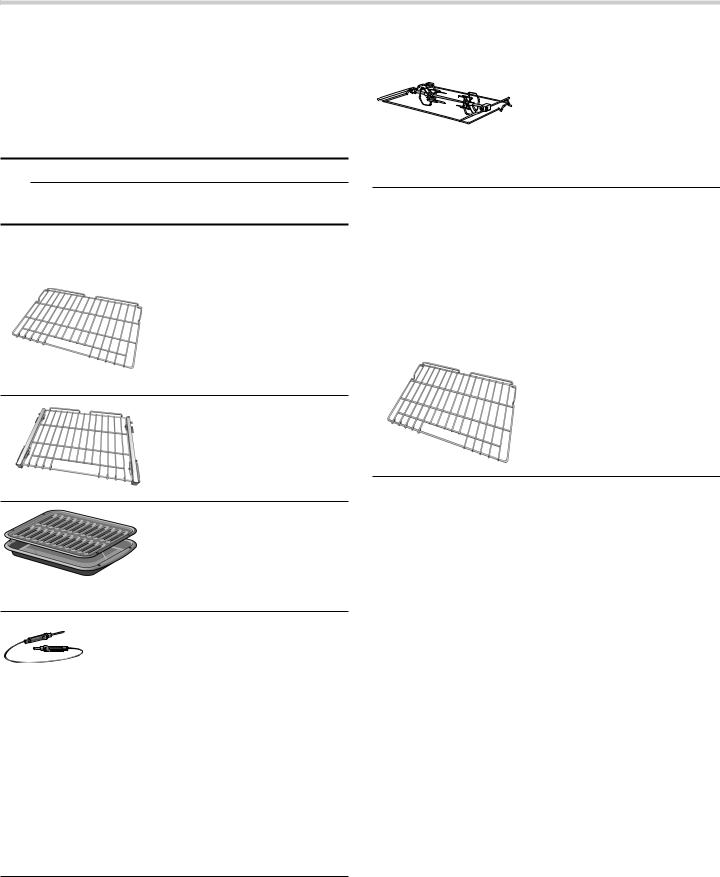
Accessories
Your appliance is accompanied with a variety of accessories. Below is an overview of the accessories included and information on how to use them correctly.
Accessories listed below can be ordered through Thermador’s eshop. The address is
Store.thermador.com/us.
9CAUTION
Do not slide any accessories between the rack positions. This may cause the accessory to tip.
Accessories Included
Wire Rack
For baking sheets, cake pans and ovenproof dishes.
Do not clean in the self-clean oven.
Telescopic Rack
Allows for easier access when inserting or removing food.
Do not clean in the self-clean oven.
Broil Pan and Grid
Use for broiling and roasting.
Remove from oven when running Self Clean mode.
Meat Probe
Depending on your oven model, the oven comes with a Single-Point or Multi-Point Meat Probe.
Single-Point Meat Probe
One measurement point determines the internal doneness or the end temperature of many foods, especially meats and poultry.
Multi-Point Meat Probe
Three measurement points enable precision roasting to your exact requirements.
Its use is described in the relevant section.
Rotisserie
Use this accessory when using the rotisserie mode. See Rotisserie under Conventional Oven Operation Chapter for additional information.
Do not clean in the self-clean oven.
Only use original accessories. They are specially adapted for your appliance.
You can buy accessories from Customer Service, from specialist retailers or online.
Note: The accessories may deform when they become hot. This does not affect their function. Once they have cooled down again, they regain their original shape.
Special Accessories (not included)
Self Cleaning Rack (3 Pack) (available via eShop)
#SDCLNRCK30
For ovenware, cake pans and ovenproof dishes.
These racks do not need to be removed during self clean.
9
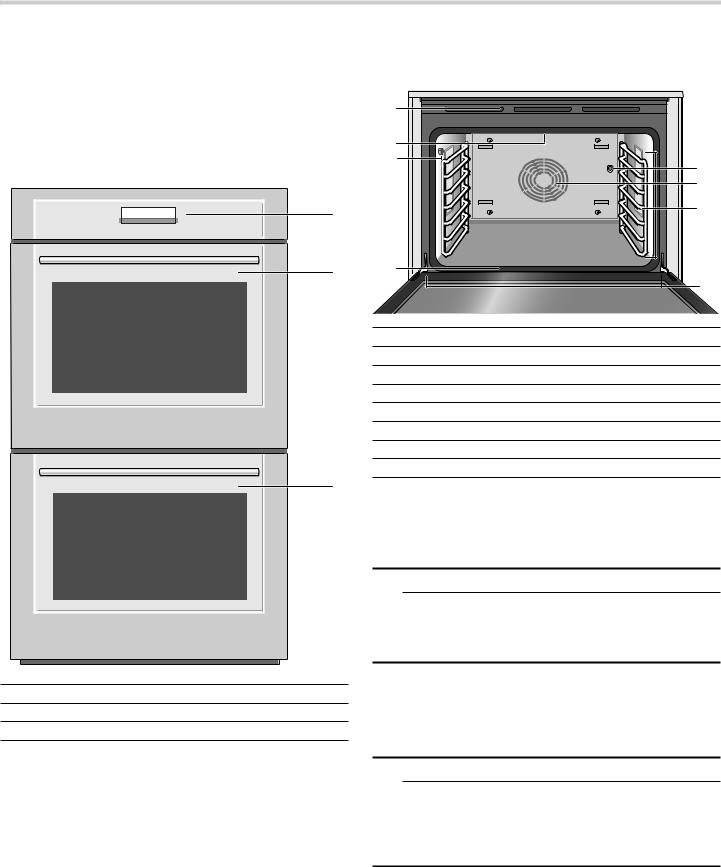
Getting to Know the Appliance
This section outlines and describes the features, indicators and controls of the appliance. You will also find information on the various functions of your appliance.
Note: Picture shows a double oven. Depending on the appliance model, individual details and colors may differ.
Oven Overview
|
|
|
7UXH &RQYHFWLRQ |
|
|
$ |
|
|
|
|
|
³ |
|
|
|
|
|
|
|
Ý |
|
|
|
21 O 2)) |
/,*+7 |
7,0(56 |
0(18 |
)$67 35(+($7 |
,1)2 |
/2&. |
67$57 O 6723 |
|
|
|
|
|
|
|
% |
&
AControl panel and display
BUpper oven cavity
CLower oven cavity
Oven Cavities
|
|
|
|
|
|
|
1Convection system
2Accessory racks
3Door hinges
4Door gasket
5Meat probe socket
6Broil element
7Oven vents
8Rotisserie socket
Oven Bottom
The oven bottom conceals the lower heating element. As a result the element is protected from damage and spills.
Tip: Do not place food directly on the oven bottom.
9WARNING
Do not use aluminum foil or protective liners to line any part of the appliance, especially the oven bottom. Installation of these liners may result in a risk of electric shock or fire.
NOTICE: Do not place broil pan on the oven bottom to catch spills. Doing so will damage the oven bottom porcelain.
9WARNING
NEVER cover any slots, holes or passages in the oven bottom or cover an entire rack with materials such as aluminum foil. Doing so blocks air flow through the oven. Aluminum foil linings may also trap heat, causing a fire hazard.
10
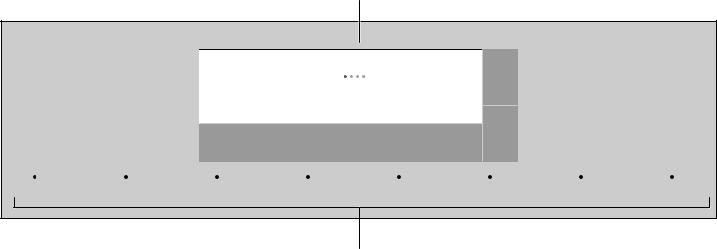
Oven Cavity Features
Oven Vent
The oven vent is located along the top and bottom of the unit. Warm air may be released from the vent before, during and after cooking. It is normal to see steam escaping from the vent and condensation may collect. This area may be warm when the oven is in use. Do not block the vent since it is important for air circulation.
Cooling Fan
The cooling fan runs based on the oven temperature. Warm air may be felt as it is released from the oven vents while the fan operates. The fan may also operate after the oven is off.
Convection Fan
The convection fan operates during all convection modes. When the oven is operating in a convection mode, the fan turns off automatically when the door is opened.
Oven Light
When you open the appliance door, the oven light turns on. If the door remains open for longer than 20 minutes, the lighting switches off again. To turn the light back on, touch the LIGHT button.
Control Panel
You can set your appliance's various functions on the control panel using the full touch color display. The full touch color display shows you the current settings.
If you have purchased a triple oven model, which includes a warming drawer, the control panel of your oven will appear slightly different.
Where the LOCK button currently appears will be changed to DRAWER. This is the button used to operate
the warming drawer from the control panel. The LOCK function is now turned on and off using the TIMERS button.
If you have purchased a combination oven model that includes a microwave oven, please consult the Use and Care Guide included with the microwave oven and make sure you read and understand all Important Safety Notes that are included.
+HDWLQJ 0RGHV
T
ÊÆ 6HWWLQJV(DV\ &OHDQ 6HOI &OHDQ
U
21 O 2)) |
/,*+7 |
7,0(56 |
0(18 |
)$67 35(+($7 |
,1)2 |
/2&. |
67$57 O 6723 |
(Full touch color display
0Touch buttons
Operating Controls
Use the controls to set your appliance simply and directly.
Touch Buttons
There are sensors under the touch buttons. Press on the words of the touch buttons to select a function. The available functions are indicated by a light above the respective touch button. Depending on the operation you are running, the number of available functions can change.
Touch button |
Use |
|
|
ON I OFF |
Switches the appliance on or off |
LIGHT |
Switches the appliance light on or off |
|
|
TIMERS |
Sets the kitchen timer, or cooking |
|
time |
MENU |
Selects operating modes and |
|
settings |
|
|
FAST PREHEAT |
Activates/Deactivates fast preheating |
INFO |
Displays additional information |
|
|
LOCK |
Activates/Deactivates panel lock |
|
|
START I STOP |
Starts or pauses the operation |
11
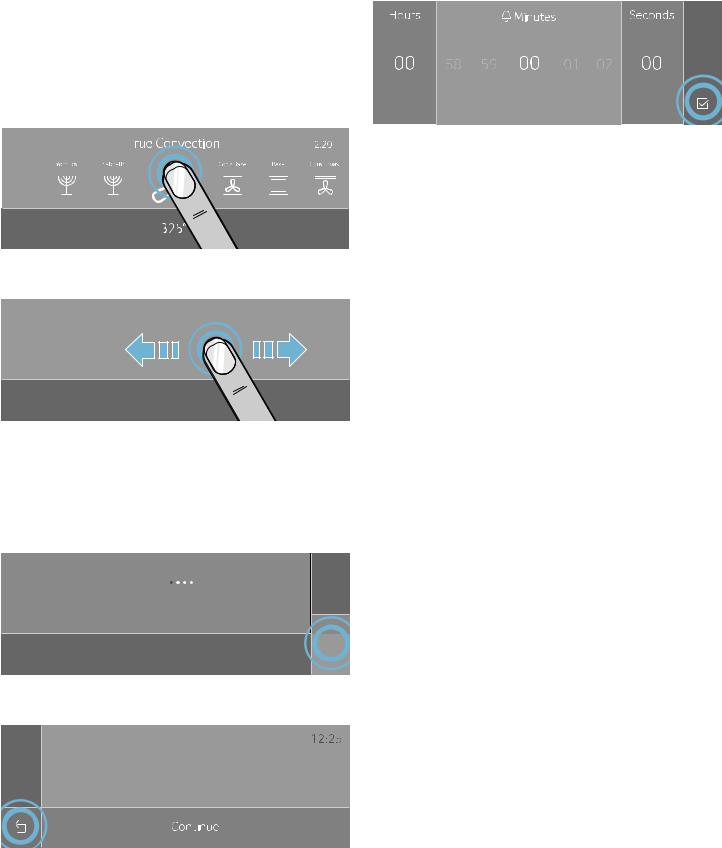
Full Touch Color Display
Use the full touch color display to navigate through the menus and select the settings. The feature that is active will be illuminated in blue.
Basic way of operating the display:
To select a feature/setting, touch the desired area on the display.
The touch screen also supports swiping to move left or right through the various settings.
|
|
|
&RQYHFWLRQ %DNH |
|
|
<RP 7RY |
6DEEDWK |
7UXH &RQY |
|
&RQY 5RDVW |
5RDVW |
° |
° |
³ |
|
|
In some instances you have further options to navigate through the menu:
For double ovens: Touch the q symbol to select the upper oven cavity. Touch the r symbol to select the lower oven cavity.
The settings you make afterwards will only affect the oven cavity you have selected.
|
+HDWLQJ 0RGHV |
|
T |
(DV\ &OHDQ 6HOI &OHDQ |
|
6HWWLQJV |
|
Ê Æ |
|
|
Some operations allow returning to the prior screen by touching the ; symbol.
(DV\ &OHDQ
Main Menu
Touch the MENU touch button to access the main menu.
Menu |
Use |
|
|
|
|
¢ |
Heating Modes |
|
Select the desired conventional |
||
|
heating mode and temperature for |
|
|
your food |
|
š |
Easy Clean |
|
Uses steam to help lift food soils for |
||
|
cleaning |
|
˜ |
Self Clean |
|
Cleaning the oven cavity |
||
|
||
|
|
|
4 |
Settings |
|
Individually adjusting the appliance |
||
|
settings ~ "Adjust Basic Settings" |
|
|
on page 16 |
|
F |
Remote Start |
|
This symbol appears when the Home |
||
|
Connect set-up is complete. |
Some operations allow confirmation by touching the 8 symbol.
12
Heating Modes Menu
Your appliance has multiple heating modes. After switching the appliance on, the Heating Modes menu is the default menu. The pre-selected mode is Convection
Heating Modes Menu Conventional Oven
Bake. You may then choose your desired heating mode by scrolling left or right.
Heating mode |
Temperature |
Use |
|
|
|
°F (°C) |
|
|
|
|
|
‚ |
True Convection |
150-525° |
For baking and cooking small food items on one or more racks. |
|
(65-275°) |
The fan distributes the heat from the ring heating element in the |
|
|
|
|
back panel evenly around the oven cavity. |
|
|
|
|
|
Convection Bake |
150-525° |
Use for large baked items and breads on 1 or 2 racks. Also |
¶ |
|
(65-275°) |
suitable for side dishes and casseroles. |
|
Heat is emitted from above and below while the fan distributes |
||
|
|
|
|
|
|
|
the heat evenly around the oven cavity. |
|
|
|
|
ƒ |
Bake |
150-525° |
For traditional baking and roasting on one level. Especially |
|
(65-275°) |
suitable for cakes on multiple racks. Heat is emitted evenly from |
|
|
|
|
the top and bottom. |
|
|
|
|
þ |
Convection Roast |
150-525° |
Roasting of poultry, larger pieces of meat and vegetables. |
|
(65-275°) |
Heat is emitted from above and below while the fan distributes |
|
|
|
|
heat evenly around the oven cavity. |
|
|
|
|
ü |
Roast |
150-525° |
For roasting poultry or meats. |
|
|
(65-275°) |
The heat is emitted from above and below. |
¿ |
Warm |
150-225° |
For keeping cooked food warm. |
|
|
(65-110°) |
|
÷ |
Speed Convection |
150-525° |
For frozen convenience foods. |
|
(65-275°) |
Heat is emitted from top and bottom while the fan circulates hot |
|
|
|
|
air around the food. |
ý Dehydrate |
100-160° |
For drying herbs, fruits and vegetables. |
|
|
|
(40-70°) |
|
|
Slow Roast |
150-250° |
For gentle slow cooking of seared, tender pieces of meat in |
ÿ |
|
(65-120°) |
ovenware without a lid. |
|
|
Heat is emitted evenly from the top and bottom at low |
|
|
|
|
|
|
|
|
temperatures. |
|
|
|
|
ù |
Max Convection Broil |
450°-550° |
For thick tender cuts of meat, poultry and fish. Uses the larger |
|
(230°-290°) |
broil element with the convection fan to allow for more food to |
|
|
|
|
cook at one time. |
‡ |
Convection Broil |
450-550° |
For roasting poultry, whole fish and larger pieces of meat. |
|
(230-290°) |
The broil element and the fan switch on and off intermittently. |
|
|
|
|
The fan circulates the hot air around the food. |
‰ |
Broil |
450-550° |
For broiling flat items, such as steaks or hamburgers, for |
|
(230-290°) |
making toast, and for cooking au gratin. |
|
|
|
|
The whole area under the broil heating element becomes hot. |
|
|
|
|
ú |
Pizza |
150-525° |
For preparing pizza fresh or frozen. |
|
(65-275°) |
Heat is emitted from above and below. The fan distributes the |
|
|
|
|
heat evenly around the oven cavity. |
Π|
Proof |
85-110° |
For yeast doughs and sourdough. |
|
(30-45°) |
Dough will rise considerably more quickly than at room |
|
|
|
|
temperature. The surface of the dough does not dry out. |
μ |
Rotisserie |
175°-550° |
For roasting poultry and large pieces of meat. Food is slowly |
|
(80°-290°) |
turned on a skewer. |
|
|
|
|
Uses heat radiated from the upper element. |
|
|
|
|
ˆ |
Max Broil |
450°-550° |
For cooking thin, tender cuts of meat, poultry and fish. Uses the |
|
|
(230°290°) |
larger broil element to allow cooking more food at one time. |
13

› |
Sabbath |
100-450° |
Will appear in Heating Modes if enabled in Settings. |
|
|
(40-230°) |
See Sabbath Mode section under General Operations Chapter. |
› |
Yom Tov |
100-450° |
Will appear in Heating Modes if enabled in Settings. |
|
|
(40-230°) |
See Yom Tov Mode section under General Operations Chapter. |
General Tips-Conventional Oven |
Aluminum Foil |
||
Pan Placement |
9 |
WARNING |
|
Baking results are better if pans are placed in the center |
|||
|
|
||
of the oven. If baking more than one pan on a rack, allow |
|
Do not use aluminum foil or protective liners to line |
|
at least 1" to 1 ½ " of air space around the pan. |
|
any part of the appliance, especially the oven |
|
|
|
bottom. Installing these liners may result in risk of |
|
One Rack Baking |
|
electric shock or fire. |
|
For best results when baking layer cakes on one rack, |
|
|
|
use Bake Mode. Place the cakes on rack 4 in the oven |
Preheating the Oven |
||
as shown below. |
|||
|
Place oven racks in desired position before heating |
||
2 Cakes, Rack Level 4 |
|||
|
the oven. |
||
|
|
Preheat the oven when using the Bake, Convection |
|
|
|
Bake, True Convection, Pizza, Broil, Convection Broil, |
|
|
|
and Warm modes. |
|
|
|
Preheat is not required for Speed Convection, Roast, |
|
|
|
Convection Roast, Proof, and Dehydrate modes. |
|
|
|
Allow oven to preheat while preparing recipe |
|
|
|
ingredients or food items. |
|
|
Setting a higher temperature does not shorten preheat |
||
|
|
time. |
|
|
|
Once oven is preheated, open the oven door and |
|
Multiple Rack Baking for Cakes |
|
place food in the oven as quickly as possible to |
|
|
minimize the loss of heat and reduction of oven |
||
When baking four layer cakes at the same time, stagger |
|
temperature. |
|
|
|
||
pans on two racks so that one pan is not directly above |
|
Use Fast Preheat to speed up preheating. |
|
the other. For best results use Bake mode. Place the |
Preheat Reminders |
||
cakes on racks 3 and 5, staggering the cakes in the |
|||
The lower element is hidden under the oven bottom. It is |
|||
oven as shown below. |
|||
|
normal that the preheat time is different than your |
||
4 Cakes, Rack Placement 3 and 5 |
previous oven that had an exposed element on the |
||
bottom. |
|||
|
|
Preheating is not necessary for meats, poultry, |
|
|
|
casseroles and Speed Convection mode. |
|
|
|
Preheat time will be longer when the electrical supply |
|
|
|
to your house is less than 240 volts. |
|
|
|
Increasing the oven temperature will require a longer |
|
|
|
preheat time. For example, the preheat time for 425° F |
|
|
|
is longer than the preheat time for 350° F. |
|
|
When broiling, preheat the oven 3-4 minutes. Do not |
||
|
preheat for more than 5 minutes. |
||
|
For Best Results |
||
|
Use the cooking recommendation charts which can be |
||
|
|
found in the Cooking Charts Use and Care Guide. |
|
|
|
Open the door as briefly as possible to avoid |
|
|
|
temperature reduction. |
|
For best results when baking cookies on multiple racks, |
Use the interior oven light to view the food through the |
||
|
oven window rather than opening the door frequently. |
||
use True Convection mode. Place cookies on racks 3 |
|
||
|
Use the timer to keep track of cooking times. |
||
and 6. |
|||
|
|
||
14

Baking Pans and Dishes
Glass baking dishes absorb heat. Some cookware manufacturers recommend reducing the temperature 25° F when using this type of dish. Follow manufacturers’ recommendations.
Use pans that provide the desired browning. For tender, light, golden brown crusts, use light, anodized or shiny metal bakeware.
Dark, rough or dull pans (nonstick or anodized) will absorb heat and result in a browner, crisper crust. Some manufacturers recommend reducing the temperature 25° F when using this type of pan. Follow manufacturers’ recommendations.
Insulated cookie sheets or bakeware may increase the length of cooking time.
Do not set broil pans or any other heavy object on the open oven door.
Do not keep the empty broil pan in the oven during cooking as this changes cooking performance. Store the broil pan outside the oven.
Condensation
It is normal for certain amount of moisture to evaporate from the food during any cooking process. The amount depends on the moisture content of the food. The moisture may condense on any surface cooler than the inside of the oven, such as the control panel.
Before First Use
Before you can use your new appliance, you must enter certain settings. You must also clean the oven cavity and accessories.
Before Using the Appliance for the First Time
Appliance must be properly installed by a qualified technician before use.
Remove all packing materials from inside and outside the oven.
While cool, wipe with a clean, damp cloth and dry.
There may be a slight odor from your new appliance; this is normal and will disappear after a short time.
Optimum cooking results depend on proper cookware being used.
Read and understand all safety precautions and Use and Care Manual information.
Execute the following sections prior to operating:
Initial Use
As soon as the appliance is connected to the power supply, the first setting "Time of day" appears on the display.
Setting the time of day
1.Touch the bottom line.
The time setting options are displayed.
+RXUV 0LQXWHV
2.Touch the “Hours” touch field and swipe to the left or right to select the current hour.
3.Touch the "Minutes" touch field and swipe to the left or right to select the current minute.
4. Touch the 8 symbol to apply the settings.
Setting the language
1. Touch the bottom line.
7LPH RI 'D\ /DQJXDJH &ORFN 'LVSOD\
6HW WKH ODQJXDJH \RX UHTXLUH
(QJOLVK
2.Swipe to the left or right to select the required language.
/DQJXDJH
6HW WKH ODQJXDJH \RX UHTXLUH
(VSDxRO |
(QJOLVK |
)UDQoDLV |
|
|
|
3. Touch the top line.
Setting the Clock Display
1.Touch "Clock display".
2.Touch the bottom line.
3.Swipe to the left or right to select “digital” or “analogue”.
4.Touch the top line.
15
Setting up Home Connect
You can start the Home Connect assistant to connect to the Home Connect network and pair your mobile device.
1.Touch “Home Connect”.
2.Touch “Start assistant”.
3.Follow the instructions in the chapter “Home Connect”.~ "Home Connect" on page 30
Note: You can also activate this feature later in the “Settings” menu.~ "Adjust Basic Settings" on page 16
Notes
You can change these settings at any time in the basic settings.
After connecting the appliance to the power or following a power failure, the settings for initial use are shown in the display.
Cleaning the Accessories
Clean the accessories thoroughly using soapy water and a dish cloth or soft brush.
Adjust Basic Settings
You can adjust various settings of your appliance, to make using your appliance easy and convenient. If necessary, you can change these settings in the menu “Settings”.
Changing the Settings
1.Touch the ON l OFF touch button.
2.Touch the MENU touch button.
3.Swipe to the left or right to select "Settings 4".
4.Touch “Continue”.
5.Swipe to the left or right to select the desired setting.
6.Touch the bottom touch field.
7.Swipe to the left or right to select the desired setting.
8.Touch the 8 icon (where applicable) to apply the setting.
9.Touch the MENU touch button.
10.Touch "Save" to save the changes.
Available Settings |
|
|
|
|
|
Setting |
Option |
|
|
|
|
Time of day |
Time in hours and minutes |
|
|
|
|
Language |
English, Français, Español |
|
|
|
|
Clock format |
12 hr, 24 hr |
|
Clock display |
Digital, Analogue |
|
|
|
|
Temperature |
Fahrenheit (°), Celsius (°C) |
|
format |
|
|
Signal volume |
1 - 5 |
|
|
|
|
Key press sound |
On, Off |
|
|
|
|
Display |
1 - 5 |
|
brightness |
|
|
|
|
|
Standby mode |
On, Off |
|
|
|
|
Start-up |
On, Off |
|
animation |
|
|
|
|
|
Convection |
On, Off |
|
Conversion |
Decreases oven temperature by |
|
|
25° F (4 °C) |
|
|
|
|
Temperature |
|
Temp offset: Upper |
offset |
|
-35°F to +35° F |
|
|
(-20 °C to +20 °C) |
|
|
Temp offset: Lower |
|
|
-35°F to +35° F |
|
|
(-20 °C to +20 °C) |
|
|
|
Sabbath mode |
On, Off |
|
Home Connect |
WiFi: On, Off |
|
|
Remote control: On, Off |
|
|
Disconnect from network |
|
|
Connect to app |
|
|
Show network status |
|
|
Customer Service access: |
|
|
|
Allow (Display shows t) |
|
|
Deny |
|
|
|
Demo mode |
On, Off |
|
Factory settings |
Restore |
|
|
|
|
Customer |
Displays Customer Service contact |
|
Service |
information |
|
16

General Operation
You have already learned about the controls and how they work. Now we will explain how to apply settings on your appliance. You will learn about what happens when you switch the appliance on and off, and how to select the operating mode.
High Altitude Baking
When cooking at high altitudes, recipes and cooking times will vary.
Switching the Appliance On and Off
Touch the ON l OFF touch button to switch the appliance on or off.
On the display, you will see whether the residual heat in the oven cavity is still high after switching the appliance off. “Oven hot” is displayed in the left lower corner of the display.
Notes
Certain displays and notes, such as those relating to the residual heat in the oven cavity, remain visible on the display after the appliance has been switched off.
After device operation, the cooling fan may continue to operate until the oven cavity has cooled.
Switch off your appliance when you do not need to use it. If no settings are applied for a long time, the appliance switches itself off automatically.
Timer Options
Your appliance will beep once your set time has elapsed.
Timer option |
Use |
|
|
|
|
. |
Kitchen Timer |
The kitchen timer works like any |
|
|
standard egg timer. The appliance |
|
|
does not switch on and off auto- |
|
|
matically. |
|
|
|
+ |
Oven Timer |
After the set time has elapsed, the |
|
|
appliance switches off automati- |
|
|
cally. |
|
|
|
* |
End time |
The appliance switches on and off |
|
|
automatically after setting a cook- |
ing time and end time.
Displaying and hiding timer options
To display or hide the timer options, touch the TIMERS touch button.
Note: The timer options displayed are hidden automatically after a particular time. If you have already set a cooking time, this is automatically stored.
Oven Timer
You can set the cooking time for your meal on the appliance. This means that the oven will turn off after the oven timer is complete. This offers convenience for you so you do not need to interrupt other work to tend to your meal.
1.Touch the ON l OFF touch button.
2.Set the heating mode and temperature.
3.Touch the TIMERS touch button.
The timer options are shown on the display.
.LWFKHQ 7LPHU |
2YHQ 7LPHU |
(QG 7LPH |
|
PLQ V |
K PLQ |
|
|
|
|
|
|
&DQFHO |
&DQFHO |
5HVHW |
|
|
|
|
|
4.Touch the “+ Oven Timer” touch field.
5.Touch the required field and swipe to the left or right to set the oven timer.
You can set hours and minutes.
+RXUV |
0LQXWHV |
|
|
|
6.Touch the 8 symbol.
The heating mode and the cook time are displayed.
7.Touch the START l STOP touch button.
The appliance starts heating and the cook timer begins to count down.
|
7UXH &RQYHFWLRQ |
|
|
|
³ |
|
|
|
|
|
|
|
|
K PLQ |
|
|
|
|
|
Note: When the set time has elapsed, a signal sounds. “Oven Timer completed” is displayed. The appliance ends the operation automatically. Touch the ON l
OFF touch button to turn off the appliance.
17

Kitchen Timer
The Kitchen Timer can be set when the appliance is switched on or off.
1.Touch the TIMERS touch button.
The kitchen timer is shown in the display.
If the appliance is switched on, first touch the . field.
2.Swipe to the left or right to select the timer value. You can set hours, minutes and seconds.
+RXUV |
0LQXWHV |
6HFRQGV |
3.Touch the 8 icon.
The kitchen timer begins to count down.
The . symbol and timer value are displayed in the top left corner of the display.
Note: When the set time has elapsed, a signal sounds. “Kitchen Timer completed” is displayed.
Delayed Operation - "End time"
The appliance switches on automatically, then off at the time preselected for the end of operation. To do this, you set the cooking time and specify the end of operation.
Delayed operation can only be used in combination with a heating mode.
Notes
Ensure that food is not left in the oven cavity for too long, as it may spoil.
The option to delay the start of operation is not available for every heating mode.
9CAUTION
To maintain food safety, do not leave food in the oven for more than one hour before or after cooking.
1.Place the food onto the appropriate accessory in the oven cavity and close the appliance door.
2.Touch the ON l OFF touch button.
3.Set the heating mode.
4.Touch the TIMERS touch button. The timer options are shown in the display.
5.Select Oven Timer and set a cook time. Touch the 8 icon.
6.Select TIMERS again and set End Time. Touch the 8 icon.
7.Touch the START l STOP touch button.
The appliance waits until the appropriate time to start the operation.
As soon as the end time has been reached, an audible signal sounds and the appliance ends the operation automatically.
Checking, changing or deleting settings
1.Touch the TIMERS touch button.
The time-setting options are shown in the display.
2.Touch the required timer option.
3.Swipe to the left or right on the touch display to change the settings.
To delete a timer value, set “00:00“, or touch “Cancel”.
Setting a Heating Mode
Use the touch buttons and the touch fields on the touch screen to enter the different operating menus.
Example: True Convection with 325° F (160 °C)
1.Touch the ON l OFF touch button to switch on the appliance.
You go directly to the heating modes menu.
2.For double ovens, touch the symbol for the oven cavity you want to use:
q - Upper oven cavity r - Lower oven cavtiy
3.Swipe to the left in the top line of the display to select “True Convection” ‚.
7UXH &RQYHFWLRQ
5RWLVVHULH |
0D[ %URLO |
0D[ &RQY %URLO |
&RQY %DNH |
%DNH |
&RQY 5RDVW |
Å ³
4.Swipe to the left or right in the bottom line of the display to select the temperature.
7UXH &RQYHFWLRQ |
|
||
|
³ |
|
|
|
|
|
|
|
|
|
|
|
|
|
|
18

5.Touch the START l STOP touch button to start the appliance operation.
The status bar appears in the display to indicate the preheating progress.
7UXH &RQYHFWLRQ
³
When the appliance has reached the set temperature, “Oven preheated” is displayed and an audible signal sounds. The oven continues cooking with the set temperature.
Double Ovens:
The settings for the two oven cavities are shown side by side on the display. The upper cavity is on the left, the lower cavity on the right side of the display.
7UXH &RQYHFWLRQ |
%DNH |
|
|
|
|||
³ |
|
|
|
|
|
|
|
|
|
|
|
|
|
|
To adjust the settings, touch the field of the required oven cavity on the display.
Note: You can only set one oven at a time.
The display icons for the upper q and lower r oven cavity light up in different colors:
Blue |
The oven cavity is selected; you can set |
|
the oven |
|
|
White |
The oven cavity is operating |
Grey |
The oven cavity is inactive |
|
|
Default Values
The appliance suggests a temperature or setting for each heating mode. You can accept this value or change it in the appropriate area.
Preheating Bar
7UXH &RQYHFWLRQ
³
As soon as a new heating mode is started, the preheating bar appears on the display. The preheating bar indicates the temperature increase in the oven cavity. When the oven is fully preheated, a sound signal will occur.
INFO Touch Button
If the INFO touch button lights up, important information regarding the mode you are using is available. This may include for example recommendations on suitable cookware or how to prepare food for a safe cooking result. When you touch the INFO touch button, the information is displayed for a few seconds.
To exit the INFO text immediately, touch the INFO touch button or the display.
Sounds
The appliance uses various sound signals during operation. A sound signal can be heard whenever you use a touch button or touch field, or when an operation is started or finished. You can adjust these sounds in the Settings menu. ~ "Adjust Basic Settings" on page 16
Changing or Cancelling the Appliance Operation
Note: In a double oven, if both cavities are operating, it is necessary to select the cavity in which you wish to make changes.
Changing the appliance operation
1.Use the START l STOP touch button to stop the operation.
2.Touch the area for the setting that should be changed.
3.Swipe to the left or right to change the setting.
4.Use the START l STOP touch button to start the changed operation.
Notes
If only adjusting temperature, the oven may restart automatically.
The cooling fan may continue to run while an operation is interrupted.
Cancelling the appliance operation
Press the START l STOP button to cancel the appliance operation.
Note: With double ovens, if both cavities are operating the cavity must be selected before pressing START|STOP.
19
Fast Preheat
With "Fast Preheat", you can shorten the preheat time required for some heating modes.
Fast Preheat is available for the following modes:
True Convection
Convection Bake
Bake
Roast
Convection Roast
To achieve an even cooking result, do not place your food or accessories into the oven cavity until
“Fast Preheat” is complete.
Notes
If the FAST PREHEAT touch button is lit, the function can be activated.
To deactivate the function before it has finished, touch the FAST PREHEAT touch button.
Activating the "Fast Preheat" function
1.Set a heating mode and temperature.
2.Touch the START l STOP touch button to start the heating mode.
3.Touch the FAST PREHEAT touch button to activate the function.
The ° symbol appears on the display.
4.Once the set temperature has been reached, the "Fast Preheat" function switches itself off automatically. The ° symbol disappears from the display. Place the food in the oven cavity.
Panel Lock
Your appliance is equipped with a panel lock so that it cannot be switched on or a setting cannot be changed accidentally.
Activating and Deactivating
The appliance has to be turned off.
1.Touch and hold the LOCK touch button (or the TIMERS touch button if LOCK is not present) until "Panel Lock activated" is displayed. The lock is activated. The 1 symbol is displayed in the top left corner of the display.
2.Touch and hold the LOCK touch button (or the TIMERS touch button if LOCK is not present) until "Panel Lock deactivated" is displayed.
The lock is deactivated.
Note: If the unit has a warming drawer, the TIMERS touch button must be used.
Auto Convection Conversion
True Convection and Convection Bake modes require a 25° F (5 °C) reduction in temperature. Auto Convection Conversion reduces the temperature you enter automatically.
Enter the package or recipe temperature when setting the mode. The oven control calculates the correct temperature for these modes automatically by reducing the input temperature by 25° F (5 °C). This is then shown in the display.
To turn on this feature:
1.Go to Settings
2.Press the ON|OFF touch button to turn the oven on.
3.Press the MENU touch button.
4.Scroll over to Settings on the touch screen.
5.Select Conv. Conversion and press ON.
6.Exit Settings and select “Save” to save your settings.
Temperature Offset
This feature is useful if food is consistently either too brown or too light. The setting increases or decreases the set oven temperature according to the chosen value.
The following heating modes support this functionality:
Bake
Convection Bake
Roast
Convection Roast
True Convection
Note: The oven is carefully calibrated to provide accurate results. This feature is useful if you prefer your foods darker or lighter.
Refer to the section entitled “Adjusting Basic Settings” to apply a temperature offset.
Note: For double ovens you can set a different temperature offset for each oven cavity.
20

Meat Probe
Depending on the model, your oven comes with a singlepoint or a multi-point meat probe. This means that the probe measures the temperature either in one or in three different areas of your food ensuring the most accurate cooking results. Once the set temperature has been reached, the appliance automatically switches itself off.
Suitable Heating Modes
True Convection ‚
Convection Bake ¶
Bake ƒ
Convection Roast þ
Roast ü
Slow Roast ÿ
Notes
The meat probe measures the temperature on the inside of the food between 85° F (30 °C) and 210° F (99 °C).
Use only the meat probe supplied with your appliance. Additional or replacement meat probes can be ordered as a spare part from Customer Service.
After use, always remove the meat probe from the oven cavity. Never store it inside the oven cavity.
Inserting the Meat Probe into the Food
Before placing your food into the oven cavity, insert the meat probe into the food.
Depending on your oven model, the meat probe has one (single-point meat probe) or three (multi-point meat probe) measuring points. If you have a multi-point meat probe, ensure that the middle measuring point is inserted in the food.
Meat: For large pieces of meat, insert the meat probe at an angle from above as far as it will go into the meat. For relatively thin pieces of meat, insert the meat probe from the side at the thickest point.
Poultry: Insert the meat probe as far as it will go into the thickest point in the breast. Insert the meat probe into the poultry crosswise or lengthwise depending on its structure. Put the chicken in a roasting dish and place it on the wire rack.
Turning the food: If you wish to turn the food, do not unplug the meat probe from the oven. Once you have turned the food, check that the meat probe is correctly repositioned in the food.
If you unplug the meat probe from the oven, all settings will be reset and you will have to apply them again.
NOTICE: Ensure that the meat probe's cable does not become trapped.
To prevent the meat probe from being damaged by excessive heat, there must be a gap of at least an inch or more between the broil element and the meat probe. The meat may expand during the cooking process.
Setting and Starting Appliance Operation
9WARNING
RISK OF BURNS
The oven interior and the meat probe become very hot. Use oven mitts to plug and unplug the meat probe.
9WARNING
RISK OF ELECTRIC SHOCK
Use of a wrong meat probe can damage the insulation. Use only the meat probe intended for this appliance.
21

Notes
The set oven cavity temperature must be at least 50° F (10 °C) higher than the meat probe temperature.
To prevent the meat probe from being damaged, the oven cavity temperature must not be set higher than 480° F (250 °C).
1.Insert the meat probe into the socket on the left-hand side of the oven cavity.
Note: The probe icon will appear on the oven display screen.
2.Close the appliance door.
NOTICE: When doing so, ensure that the meat probe’s cable is not trapped in the appliance door. It may be damaged.
3.Touch the ON l OFF touch button.
4.Set the heating mode.
Note: When the meat probe is plugged into the socket, you can only select a heating mode that is suitable to be used with the meat probe.
5.Touch the oven cavity temperature on the left in the bottom line.
6.Swipe to the left or right to select the required oven cavity temperature.
7.Touch the 8 symbol to apply the setting.
8.Touch the ¥ core temperature on the right in the bottom line.
9.Swipe to the left or right to select the required core temperature.
10.Touch the START l STOP touch button. The appliance starts the operation.
Changing or Stopping the Appliance Operation
Changing: During appliance operation, you can change the oven cavity temperature and meat probe temperature.
1.Touch the oven cavity temperature or meat probe temperature.
2.Swipe to the left or right to change the temperature.
3.Touch the 8 symbol to apply the setting.
Stopping: Once the set meat probe temperature has been reached, a signal sounds and the appliance stops the operation automatically.
1.Use the ON l OFF touch button to switch off the appliance.
2.Using an oven glove, unplug the meat probe from the socket.
Core Temperatures of Different Foods
Do not use frozen food. The figures in the table are given as a guide. They will depend on the quality and composition of the food.
You can find detailed information on heating modes and temperatures in the Use and Care Cooking Charts manual.
Food |
Core temperature in |
|
°F (°C) |
|
|
Poultry |
170° (75°) |
|
|
Pork* |
145° (65°) |
Pork |
160° (70°) |
|
|
Beef, medium rare |
145° (65°) |
|
|
Beef, medium |
160° (70°) |
Beef, well done |
170° (75°) |
|
|
Lamb |
145° (65°) |
|
|
Other: Heating/reheating food |
150°-165° (65°-75°) |
*allow for a three minute rest period.
Sabbath Mode
With the Sabbath mode, a cooking time of up to
74 hours can be set. You can keep the food in the oven cavity warm without having to switch the oven on or off.
Note: Sabbath mode has to be activated in the Basic Settings, to use this mode.
Note: If you have a double oven, you can set either the Yom Tov or Sabbath mode in both oven cavities at the same time. It is not possible to mix the two modes. The set time will run simultaneously for both oven cavities.
Starting
The oven is automatically in Bake mode. The temperature can be set between 100° F (40 °C) and 450° F (230 °C).
1.Touch the ON l OFF touch button.
2.Swipe to the left or right to select "Sabbath ›".
3.Touch the temperature in the bottom line.
4.Swipe to the left or the right to select the required temperature.
5.Touch the 8 icon to apply the setting.
6.Touch the cooking time + in the bottom line.
7.Swipe to the left or the right to select the required duration.
8.Touch the 8 symbol to apply the setting.
9.Touch the START l STOP touch button.
“Sabbath Mode will start in 5min 00sec” appears on the display. After five minutes the appliance starts the operation. All controls apart from the ON l OFF and START|STOP touch buttons are deactivated. You can switch off the appliance at any time.
22
Notes
Once Sabbath mode has started, you can no longer change any settings using the START l STOP touch button.
The operation is not interrupted if you open the appliance door.
Once the Sabbath mode duration has elapsed, a signal sounds. The appliance stops heating. Use the ON l OFF touch button to switch off the appliance.
Cancelling
Touch the ON l OFF touch button to cancel the operation.
Yom Tov Mode
With the Yom Tov mode, you can set a cooking time of up to 74 hours, during which you can select from six cooking temperatures.
Note: Sabbath mode has to be activated in the Basic Settings, to use this mode.
Note: If you have a double oven, you can set either the Yom Tov or Sabbath mode in both oven cavities at the same time. It is not possible to mix the two modes. The set time will run simultaneously for both oven cavities.
Starting
The oven is automatically in Bake mode. The temperature can be set between 100° F (40 °C) and 450° F (230 °C).
1.Touch the ON l OFF touch button.
2.Swipe to the left or right to select "Yom Tov ›".
3.Touch the temperature in the bottom touch field.
4.Swipe to the left or the right to select the required temperature.
5.Touch the 8 icon to apply the setting.
6.Touch the cooking time + in the bottom touch field.
7.Swipe to the left or the right to select the required duration.
8.Touch the 8 icon to apply the setting.
9.Touch the START l STOP touch button.
“Yom Tov Mode will start in 5min 00sec” appears on the display. After five minutes the appliance starts the operation. All controls apart from the ON l OFF and START l STOP touch buttons are deactivated. You can switch off the appliance at any time.
Notes
Once Yom Tov mode has started, the temperature may be changed by pressing one of the six displayed temperatures. The display will not respond to this input, but the temperature will be adjusted in the cavity. The START l STOP touch button will not cancel the mode.
The operation is not interrupted if you open the appliance door.
Once the Yom Tov mode duration has elapsed, a signal sounds. The appliance stops heating up. Use the ON l OFF touch button to switch off the appliance.
Cancelling
Touch the ON l OFF touch button to cancel the operation.
23
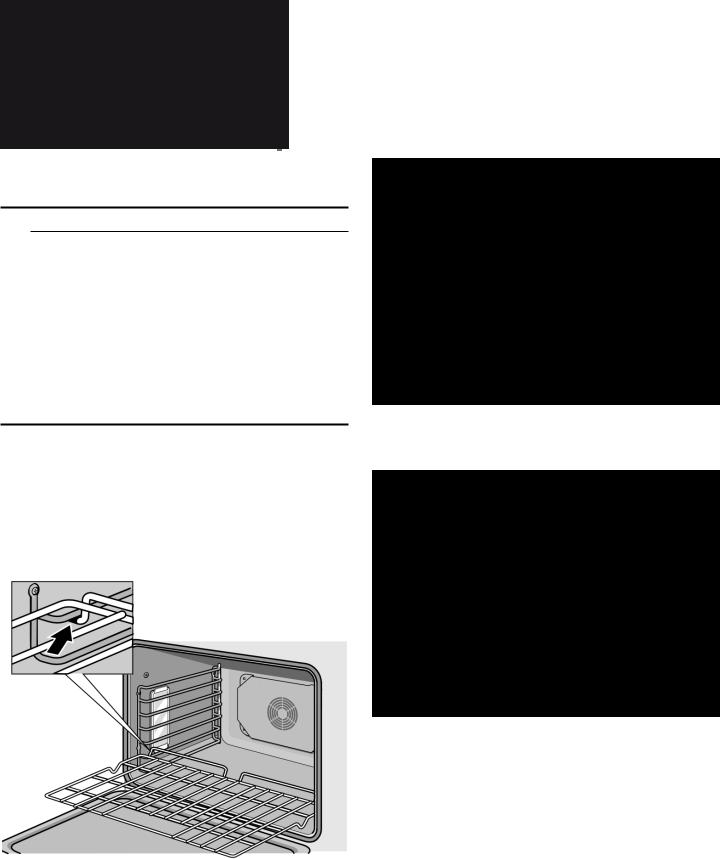
Rack Positions
There are seven positions with position one starting at the bottom of the oven. Rack positions are called out throughout the manual to help optimize cooking performance.






3.Tilt rack up to allow stop into rack guide.
4.Bring rack to a horizontal position and push the rest of the way in.
Rack should be straight and flat, not crooked.
To remove Flat Rack from Oven:
1.Grasp rack firmly on both sides and pull rack toward you.
2.When the stop is reached, tilt rack up and pull the rest of the way out.
Telescopic Rack
To insert Telescopic Rack into Oven:
1.Hold the rack at a slight angle.
2.Engage the rear hooks in the accessory brackets.
Inserting Racks
9CAUTION
To avoid burns, place oven racks in desired positions before turning oven on. Always use oven mitts when the oven is warm. If a rack must be moved while the oven is hot, do not let oven mitts contact hot heating elements.
Use caution when removing oven racks from the lowest rack position to avoid contact with the hot oven door.
To avoid possible injury or damage to the appliance, ensure racks are installed exactly per installation instructions and not backwards or upside down.
Flat Rack
The rack is designed with a stop so it will stop before coming completely out of the oven and not tilt.
To insert Flat Rack into Oven:
1.Grasp rack firmly on both sides.
2.Insert rack (see picture).
3.Hold the rack straight to allow second tab to rest over rack guide.
4.Push the rack in until it is even with the front hooks.
24

5.Lift the rack up to lock the last hook into place.
6.Push the rack in completely.
7.Engage the rack’s front hooks in the accessory brackets.
This is very important to ensure that the rack is installed correctly (see the enlarged picture).
9CAUTION
To avoid possible injury or damage to the appliance, ensure telescopic rack is installed exactly per installation instructions and not backwards or upside down.
Rotisserie
Rotisseries uses heat radiated from the upper element. Food is slowly turned on a skewer in the center of the oven. This allows food to receive equal heat on all sides.
The Rotisserie mode is best suited for cooking large pieces of meat (for example a whole chicken, turkey or a large roast). This mode helps seal in flavor and juices while allowing the meat to be cooked without the addition of fats or liquids.
The maximum weight allowed for the rotisserie is 12 lb (6 kg).
Use a meat thermometer to check the internal temperature of the meat.
Allowable oven temperature is 175 - 550°F (80 - 290°C).
Note: For double ovens, only one oven cavity will be enabled for Rotisserie mode.
Assembling the Rotisserie:
1.Insert the rotisserie rack half way into the oven on rack position 5.
2.Slide the left fork into the skewer and tighten the screw.
3.Slide meat or poultry for roasting onto the skewer and tighten the screw.
4.Slide the right fork onto the skewer and tighten the screw.
5.Check the balance of the food on the skewer by rolling the skewer in the palms of your hands. Food that is not evenly balanced on the skewer will not cook evenly.
6. Place the rotisserie skewer onto the rack.
25

7.Place the skewer rack into the oven and insert the drive shaft into the opening on the back oven wall.
8.If necessary, turn the rotisserie skewer slightly so that the drive shaft fits properly into the opening.
9.Insert flat rack on position 1 and insert broil pan to catch drippings.
Trussing Poultry for the Rotisserie
1.Slip one of the forks on the skewer with the tines pointing to the tip of the skewer. Loosely tighten the screw to keep it from slipping.
2.Insert the skewer through the poultry securing with the fork.
3.Cut 24" (61 cm) of kitchen string and lay it under the poultry, breast side up, with equal lengths of string on each side.
4.Wrap each end of the string around each of the wings; catch each wing tip as the string is brought tightly together at the top and knotted. Do not cut off the extra string.
5.Cut another 24" (61 cm) of string and lay it under the back. Wrap it around the tail and then around the skewer. Cinch tightly.
6.Pull legs forward; cross them on top of the skewer, bring string around and tie a knot.
7.Connect the string holding the legs to the string holding the wings; then knot. Add the other fork and push tines into the drumsticks to secure.
8.Check the balance by rolling the skewer in your palms. Poultry should not rotate or be loose in any way. If so, redo the trussing. The poultry will not cook evenly if it is not balanced on the skewer.
26

Start
Select Rotisserie mode. The default temperature is 400°F (200°C). Swipe to the left or right to adjust temperature and press START.
Cooking Chart for Rotisserie |
|
|
|
|
|
|
|
|
|
|
|
Food Item |
Weight (lb) |
Temp. in °F (°C) |
Time (min. per lb) |
Internal Temp. |
|
|
|
|
|
|
°F (°C) |
|
|
|
|
|
|
Beef |
|
|
|
|
|
|
|
|
|
|
|
Rib Eye Roast, Medium Rare |
3.0 - 5.5 |
400° (200°) |
17 |
- 23 |
145° (65°) |
|
|
|
|
|
|
Rib Eye Roast, Medium |
3.0 - 5.5 |
400° (200°) |
18 |
- 27 |
160° (70°) |
Pork |
|
|
|
|
|
|
|
|
|
|
|
Loin Roast, boneless |
1.5 - 4.0 |
400° (200°) |
16 |
- 24 |
145° (65°) |
|
|
|
|
|
|
Loin Roast, boneless |
1.5 - 4.0 |
400° (200°) |
20 |
- 26 |
160° (70°) |
Poultry |
|
|
|
|
|
|
|
|
|
|
|
Chicken whole |
4.0 - 8.0 |
450° (230°) |
12 |
- 17 |
180° (80°) |
|
|
|
|
|
|
Turkey, whole |
10.0 - 12.0 |
400° (200°) |
10 |
- 12 |
180° (80°) |
Turkey Breast |
4.0 - 7.0 |
400° (200°) |
16 |
- 19 |
170° (75°) |
|
|
|
|
|
|
4 Cornish Hens |
1.5 each |
450° (230°) |
60 |
- 70 min. total |
180° (80°) |
|
|
|
|
|
|
Lamb |
|
|
|
|
|
Leg, boneless, Medium |
4.0 - 6.0 |
400° (200°) |
20 |
- 23 |
160° (70°) |
|
|
|
|
|
|
Leg, boneless, Well |
4.0 - 6.0 |
400° (200°) |
27 |
- 29 |
170° (75°) |
|
|
|
|
|
|
Warming Drawer Operation
Triple ovens include a warming drawer that is operated using the oven operating panel. These appliances will have a DRAWER touch button instead of the LOCK touch button.
The warming drawer will keep hot, cooked foods at serving temperature.
9CAUTION
To maintain food safety, follow these guidelines:
i.DO NOT use the warming drawer to heat cold food (exception: it is safe to use the drawer to crisp crackers, chips or dry cereal and to warm plates.
j.Be sure to maintain proper food temperature. The USDA recommends holding hot food at 140°F or warmer.
k.DO NOT warm food for longer than one hour.
Setting the Warming Drawer
You can also use the warming drawer when the oven is in switched off.
1. Press the DRAWER touch button.
:DUPLQJ 'UDZHU
|
|
|
|
KLJK |
RII |
ORZ |
|
2.Touch the bottom line and swipe to the left or right to select the desired intensity.
Available settings are:
High
Medium
Low
Off
3.Touch the 8 icon.
The warming drawer starts operating. If you do not touch the 8 icon the warming drawer will start heating automatically after some time.
The warming drawer icon is displayed on the top left corner of the display as long as the warming drawer is running.
27
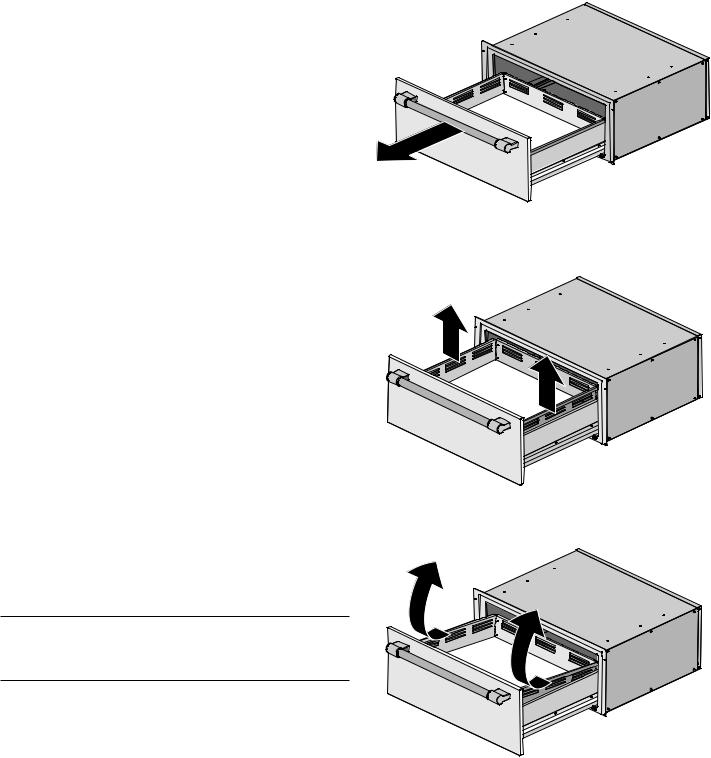
To cancel the warming drawer operation:
1.Press the DRAWER touch button.
2.Swipe right and select “off”.
3.Touch the 8 icon.
Warming Empty Serving Bowls and Plates
Use only heat-safe dishes.
Warm on low setting for cooking containers.
Check dish temperature during warming period.
Place empty plates or dishes in a cold warming drawer. Do not preheat drawer prior to placing dishes.
Warming Drawer Charts
Food Category |
Control Set- |
Cover |
|
ting |
|
|
|
|
Bacon |
High |
No |
|
|
|
Beef: medium rare |
Low |
No |
|
|
|
Beef: medium - well done |
Medium |
No |
Bread, quick: hard rolls, soft |
Medium |
Yes |
rolls, coffee cakes, biscuits, |
|
|
and toast |
|
|
Casserole |
Medium |
Yes |
|
|
|
Cereal, cooked |
Medium |
Yes |
|
|
|
Crisping: stale item |
Low |
No |
Dough (to proof) |
Proof |
Yes |
|
|
|
Eggs |
High |
Yes |
|
|
|
Fried Foods |
High |
No |
Gravy, cream sauce |
Medium |
Yes |
|
|
|
Meats: ham, lamb and pork |
Medium |
Yes |
|
|
|
Pies |
Medium |
No |
Pizza |
High |
No |
|
|
|
Potatoes, baked |
High |
Yes |
|
|
|
Potatoes, mashed |
Medium |
Yes |
Poultry, roasted |
Medium |
Yes |
|
|
|
Seafood |
Medium |
Yes |
|
|
|
Vegetables |
Medium |
Yes |
Waffle / Pancakes |
High |
No |
|
|
|
Plates |
Low |
No |
|
|
|
Plate of food |
Medium |
Yes |
Note: : Preheat all cookware prior to inserting into the warming drawer. If the cookware has previously been used to prepare a dish, then no preheating is necessary.
Remove Drawer Insert
Note: The pictures show a warming drawer model with handle. Depending on the appliance model, individual details may differ.
1. Open the drawer fully.
2.Grasp the overhanging flange of the insert about midway on each side of the drawer and lift it for approx. 2" (3 cm).
3.While holding the insert up rotate the front of the insert upward to clear the front inside of the drawer.
28
